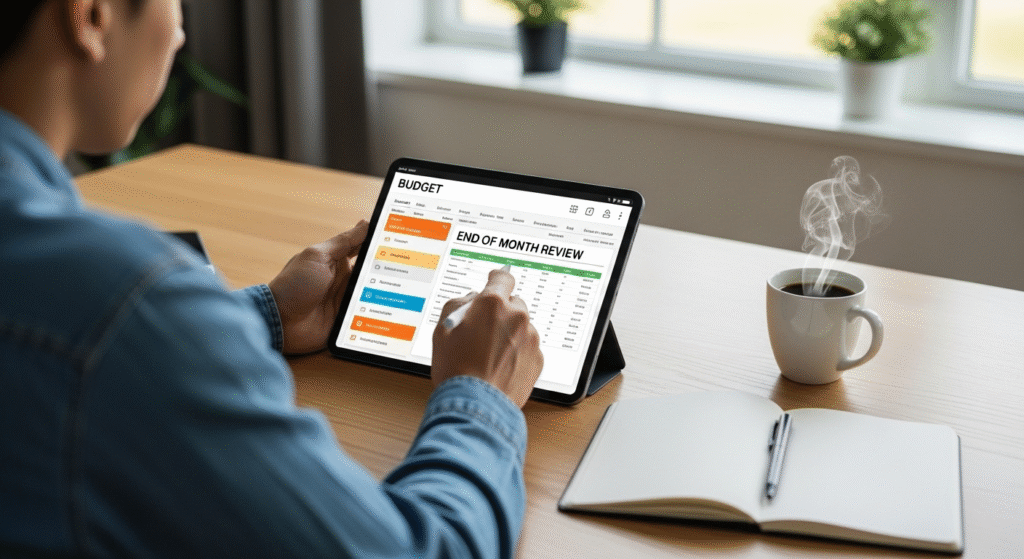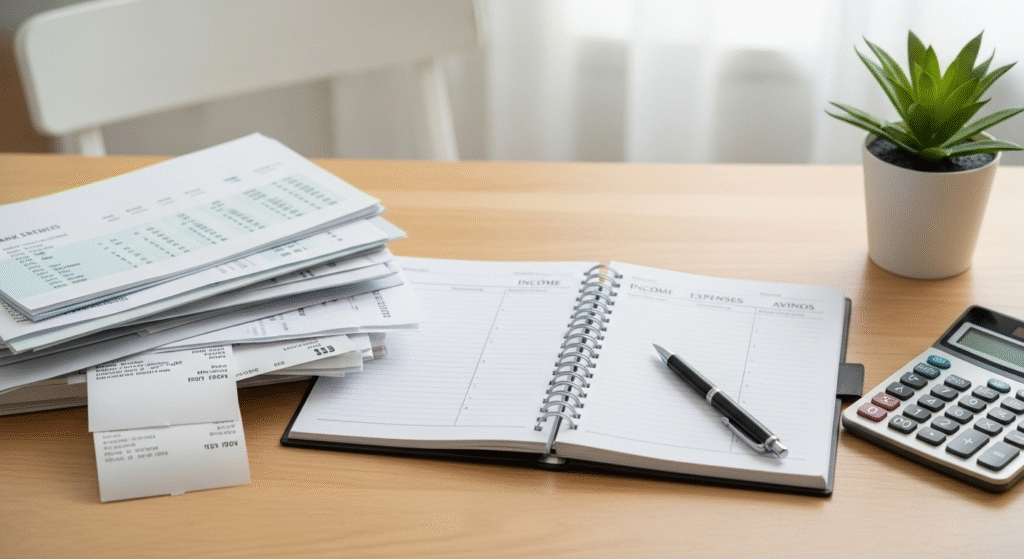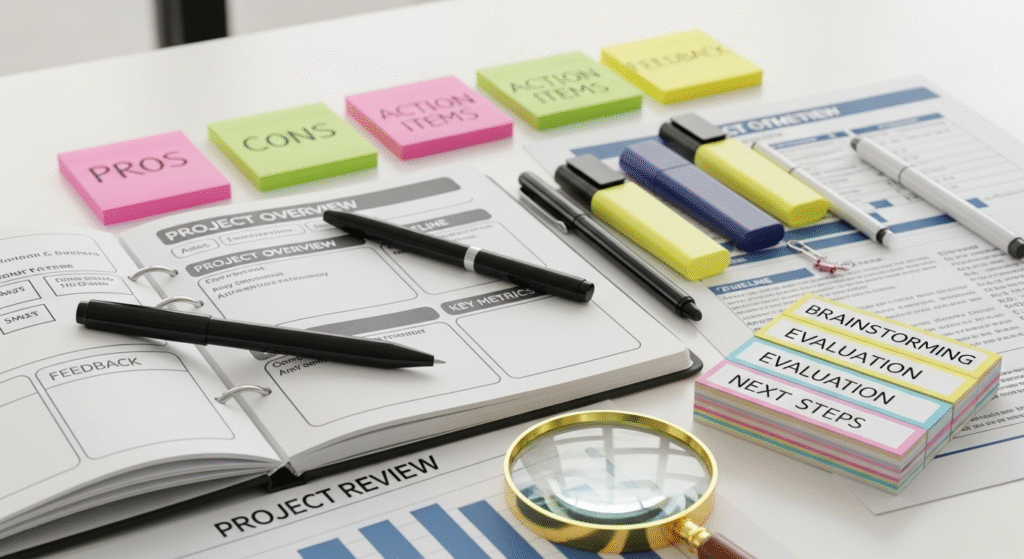
End of Month Budget Review is one of the smartest habits you can build to stay in control of your money. It helps you understand where your income goes, track your expenses, and see how well you’re meeting your financial goals. By taking just a little time at the end of each month, you can spot spending patterns, fix mistakes, and make better choices for the future.
Doing an End of Month Budget Review regularly also gives you peace of mind. You’ll know exactly how much you saved, where you overspent, and what to improve next month. This simple routine can make a big difference in mastering your finances every month.
Preparing for Your Budget Review
The key to a successful End of Month Budget Review is good preparation. Start by gathering all your receipts, bills, and bank statements from the past month. Whether they’re digital or paper copies, having them in one place helps you see where every dollar went. Make sure to include credit card statements, online subscriptions, and cash expenses.
Next, set up your budget spreadsheet or use a finance tracker app. Many people prefer tools like Google Sheets, Notion, or budgeting apps like Mint and YNAB. These tools make it easy to categorize your spending and calculate totals automatically. If you’ve been tracking your expenses daily or weekly, this part will be even simpler.
Choose a calm time to do your End of Month Budget Review, maybe a quiet Sunday evening or the first day of the new month. Having the right mindset is essential; treat this as a self-care habit, not a chore. Play soft music, grab your favorite drink, and give yourself time to reflect without stress. Preparing your workspace and mindset makes it easier to stay focused and motivated. With everything organized, you’ll be ready to review your money clearly and make smarter financial choices each month.
Step by Step Guide to Reviewing Your Budget

Doing an End of Month Budget Review doesn’t have to feel complicated. Start by comparing your planned spending with your actual expenses. Look at each category—groceries, bills, entertainment, and savings—and see if you stayed within your target. This simple comparison helps you notice habits you might not realize during the month.
Next, identify where you overspent and where you saved more than expected. Overspending isn’t always bad, it just means you can adjust your plan next time. Celebrate your small wins, like reducing dining out or saving extra for emergencies. Tracking these patterns helps you take control of your financial goals over time.
Finally, evaluate your progress toward monthly and yearly goals. Ask yourself: Did I save as planned? Am I closer to paying off debt? Reviewing these details gives you a clear picture of your growth. This step in your End-of-Month Budget Review helps you turn numbers into insights and make confident financial adjustments for the future.
Adjusting and Resetting for the Next Month
Once you’ve completed your End of Month Budget Review, it’s time to make changes for the new month. Start by reallocating funds to match your priorities. For example, if you spent less on dining out, move that extra money into savings or debt repayment. Adjusting your budget this way ensures your finances stay flexible and aligned with your goals.
Update your spending categories to reflect current needs. Maybe groceries need a bit more this month, or you want to set aside funds for an upcoming trip. Review all areas, utilities, personal spending, and savings to create a balanced plan.
Now, set new short-term and long-term targets. Maybe you want to save an extra $100, reduce a bill, or grow your emergency fund. Setting clear and realistic goals keeps your budget motivating instead of restrictive. Each End-of-Month Budget Review gives you the chance to reset, refresh, and refine your financial plan. Over time, this habit builds strong awareness and confidence in how you manage your money.
Tools and Templates to Simplify Your Review

Using the right tools can make your End of Month Budget Review faster and more effective. Budgeting apps like Mint, YNAB (You Need a Budget), and EveryDollar are great for tracking expenses automatically. They connect with your bank and categorize spending for you, saving time and effort. If you prefer manual tracking, use finance journals or printable templates to jot down expenses, savings, and goals.
End-of-month review templates can help you stay organized. You can find free ones online or create your own with sections for income, expenses, savings, and insights. Having a consistent layout helps you compare your progress month after month.
Automation can also make budgeting effortless. Set up automatic transfers to your savings account or investment fund so you never miss a goal. The more automated your system is, the less mental effort budgeting requires. A well-organized End of Month Budget Review combined with smart tools helps you stay consistent and stress-free about your finances.
Building a Monthly Financial Habit That Lasts

Turning your End of Month Budget Review into a monthly habit is one of the best ways to stay financially strong. Treat it as a positive ritual rather than a routine task. When you make time to reflect each month, you build awareness and control over your spending.
Celebrate small wins like paying off a small debt or saving more than expected. These moments of progress keep you motivated and confident. Tracking progress through charts, journals, or apps can also make your journey more visual and rewarding.
Consistency is the secret to lasting financial success. Even if you miss one month, don’t give up, get back on track. Over time, your End-of-Month Budget Review will become second nature, helping you make smarter financial choices effortlessly. With every review, you’ll grow more mindful, organized, and prepared for your long-term goals.
Conclusion
An End of Month Budget Review is one of the most effective habits for gaining complete control over your finances. By taking just a little time each month to review your income, spending, and savings, you create a clear picture of where your money is going. It helps you celebrate progress, fix problem areas, and stay focused on your financial goals. When you make your End-of-Month Budget Review a regular practice, managing money becomes easier and less stressful. You’ll start noticing positive changes—more savings, better planning, and smarter spending. With consistency and the right tools, this simple habit can transform your financial confidence and help you master your money month after month.
FAQs
What is an End-of-Month Budget Review and why is it important?
An End of Month Budget Review is a simple process of analyzing your income, expenses, and savings at the end of each month. It helps you understand where your money goes and whether you’re sticking to your budget. Doing an End-of-Month Budget Review regularly allows you to spot overspending, make better financial decisions, and stay on track with your goals. It’s a powerful way to improve financial awareness and build better money habits for long-term success.
How do I start my End-of-Month Budget Review?
To begin your End of Month Budget Review, gather all your financial documents—receipts, bills, and bank statements. Then, compare your actual expenses to your planned budget for the month. Identify areas of overspending, track savings, and note patterns that affect your goals. A proper End-of-Month Budget Review also includes setting new financial targets for the next month. This step-by-step process keeps you organized and helps you stay consistent in managing your personal finances.
What tools can help make an End-of-Month Budget Review easier?
You can simplify your End of Month Budget Review using budgeting apps like Mint, YNAB, or EveryDollar. These tools automatically track your expenses and categorize spending for quick analysis. For a manual approach, use a finance tracker journal or spreadsheet to record and review numbers. The right tools make your End of Month Budget Review faster, more accurate, and less stressful, allowing you to focus on improving your financial habits instead of crunching numbers.
How long does an End of Month Budget Review take?
An end-of-month budget review typically takes 30 to 60 minutes, depending on the level of detail you prefer. If you track your expenses throughout the month, the process becomes much faster. A quick End-of-Month Budget Review gives you clarity about your spending and helps you set realistic goals for the next month. The more consistent you are, the easier and more efficient this habit becomes over time.
